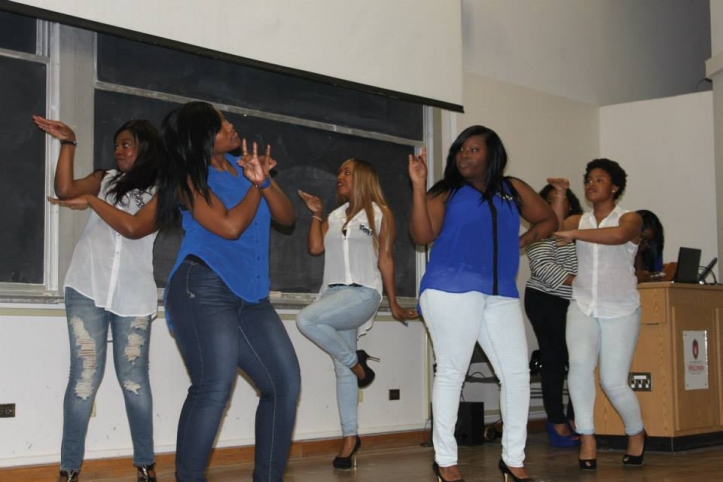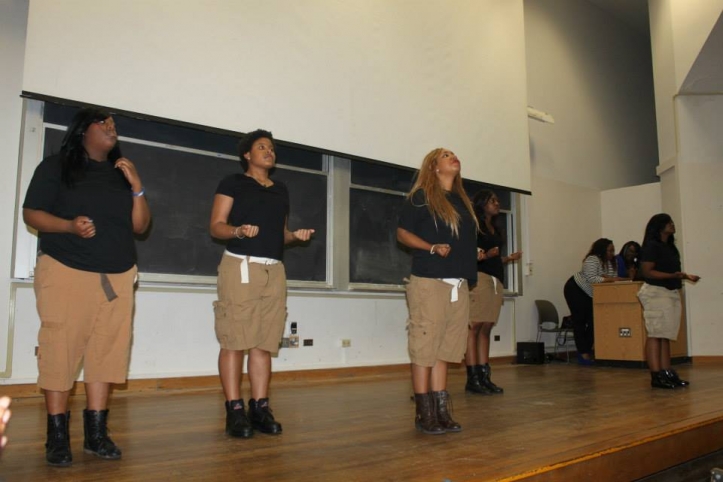Stepping at the 7th Annual Zeta Yard Show (UW-Madison)

During the 2013 spring quarter at UCLA, I decided to conduct field research on the “stepping” tradition amongst the historically black Greek-letter organizations (BGLOs) for my final project in a field and laboratory methods course. While stepping was the “object” of my study, I was also interested in the ways in which step performances were creatively assembled to create organizational distinctions as well as “Greek Unity.” Initially, the idea to research and explore stepping stemmed from two major factors: 1) my involvement with the practice from childhood to adulthood as a member of Phi Beta Sigma Fraternity; and 2) a determination to spread awareness of the tradition amongst academics, particularly in the fields of musicology and ethnomusicology. Moreover, I believed that a tradition such as stepping would be of particular interest to ethnomusicologists due to its socio-musical nature, which physically represents John Blacking’s definition of music as “humanly organized sound” (Blacking 1973:10). Therefore, I sought to do some documentation and analysis of step performances through audio and video recording, and one of my sites of research was the Zeta Yard Show on the University of Wisconsin-Madison campus. Before highlighting performances at the Zeta Yard Show, a definition of stepping and a brief acknowledgement of its developers may be useful for readers who are unfamiliar with the tradition.
Stepping, as it is known and practiced today, was developed by members of the “Divine Nine” National Pan-Hellenic Council (NPHC) on college campuses across the United States. It was within the black collegiate experience that the legacy of stepping came to fruition and has been maintained and transmitted through the years as an oral tradition. The nine fraternities and sororities that make up the body of NPHC are: Alpha Phi Alpha Fraternity, Inc. (1906); Alpha Kappa Alpha Sorority, Inc. (1908); Kappa Alpha Psi Fraternity, Inc. (1911); Omega Psi Phi Fraternity, Inc. (1911); Delta Sigma Theta Sorority, Inc. (1913); Phi Beta Sigma Fraternity, Inc. (1914); Zeta Phi Beta Sorority, Inc. (1920); Sigma Gamma Rho Sorority, Inc. (1922); and Iota Phi Theta Fraternity, Inc. (1963).
The practice of stepping itself can best be described as a series of highly physical, multilayered routines that typically involves a group of individuals stomping, clapping, patting, singing, and chanting in a synchronized manner.
This brief sound clip from the 2013 Zeta Yard Show reinforces certain organizational identity markers through singing, chanting, and stepping by Alpha Kappa Alpha Sorority, Zeta Phi Beta Sorority, Phi Beta Sigma Fraternity, and Kappa Alpha Psi Fraternity.
Another critical component of stepping is group cohesiveness, which is displayed through the uniformity of sound and bodily movement, generating a crucial audio-visual partnership. The combination of these two domains (audio and visual) through the assemblage of choreographed motions and sounds results in the compilation of a complex, multidimensional performance practice known as “stepping.” These features were on full display at the 7th Annual Zeta Yard Show at UW-Madison (to view a few of the step routines, please see the movie “Performing Identity” at the end which also provides an analysis of the recorded material).
The Zeta Yard Show took place on Saturday, May 11, 2013 in 3650 Humanities (a university lecture hall located in the central part of the UW campus). The event was completely free and open to public. Those in attendance totaled about 300 persons, and consisted of mostly university students, alumni, Greeks from the NPHC and Multi-Cultural Greek Council, and a host of supportive friends and family. One of the unique things about the Zeta Yard Show, however, is that the event is about more than just stepping; it functions to promote Greek unity and serves as an “opportunity for fraternities and sororities to showcase their organization’s mission, principles, pay homage to their founders, and to inform the campus about any service they do in the community” (Jo’Niece Monk, member of the Eta Iota chapter of Zeta Phi Beta Sorority, Inc.). In terms of how the event is organized, “it is put together by organizations selecting steps, calls, chants, and strolls that represent their organization and local chapter” [italics added] (ibid.).
During the first half of the Zeta Yard Show, the participating organizations performed routines of self-representation through songs, strolls (choreographed line dances set to music), chants, and a series of steps, all of which represented their respective fraternity or sorority. For the second half of the show, each performing group was asked to step as a different organization within the NPHC. This resulted in the female sororities performing as male fraternities, and vice-versa. In order to perform the identity of another group, the steppers would change into the colors of that fraternity or sorority, as well as perform a few of the signature step routines that represent the “swapped” organization. This swapping of colors and routines is commonly known as a “Flip-Flip Show” or, in the case of the 2013 Zeta Yard Show, a “Switch-A-Roo Show.” The following pictures illustrate performances of self-representation and the “Switch-A-Roo.”

Phi Beta Sigma Fraternity self-representation

Phi Beta Sigma Fraternity as Sigma Gamma Rho Sorority

Zeta Phi Beta Sorority self-representation

Zeta Phi Beta Sorority as Alpha Phi Alpha Fraternity
When Michael Lee of Phi Beta Sigma Fraternity, Inc. was asked about the nature of this year’s Zeta Yard Show, he stated that “generally, it's a fun show, so some of the stuff that we are going to be doing is out of the norm for myself, but it’s all about making the people laugh and enjoy their time.” Perhaps this “out of the norm” feeling he was referring to stemmed from having to engage in a cross-gendered performance; that is, although he is a man, he would have to perform as a sorority woman (this was the case for every male performing group). The women also had to make certain negotiations to render a male fraternity presentation, and both forms of cross-gendered performances generally resulted in an uproar of laughter from those in attendance.
As an entity, the Zeta Yard Show is a creative, social process that consists of strategically choreographed routines and antics that display organizational distinction as well as black Greek unity. Both distinction and unity are achieved through this production by creating a performance space through which black Greeks can engage in self-expression and learn from the other NPHC organizations through exchange and interaction. The result of these things is the formation of an interactive environment between steppers and audience that entertains while it educates.
"Performing Identity" at the 2013 Zeta Yard Show (UW-Madison)
---
References
Blacking, John. 1973. How Musical Is Man? Seattle: University of Washington Press.
---
Deonte Harris is a graduate student in the UCLA Department of Ethnomusicology.





